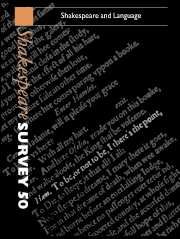Book contents
- Frontmatter
- Shakespeare’s Language and the Language of Shakespeare’s Time
- ‘I’ll plague thee for that word’: Language, Performance, and Communicable Disease
- The Language of the Spectator
- Marlowe’s Edward II: Penetrating Language in Shakespeare’s Richard II
- Hamlet’s Ear
- Secrecy and Gossip in Twelfth Night
- Shakespeare Rewriting Ovid: Olivia’s Interview with Viola and the Narcissus Myth
- ‘Voice Potential’: Language and Symbolic Capital in Othello
- Household Words: Macbeth and the Failure of Spectacle
- Erring and Straying Like Lost Sheep: The Winter’s Tale and The Comedy of Errors
- The ‘Shakespearian Gap’ in French
- Reading the Early Modern Text
- Shakespeare and the Metamorphosis of the Pentameter
- Rereading Illustrations of the English Stage
- Nietzsche’s Hamlet
- ‘Strange and woonderfull syghts’: The Tempest and the Discourses of Monstrosity
- Shakespeare Performances in England, 1996
- Professional Shakespeare Productions in the British Isles, January–December 1995
- 1 Critical Studies
- 2 Shakespeare’s Life, Times, and Stage
- 3 Editions and Textual Studies
- Books Received
- Index
The ‘Shakespearian Gap’ in French
Published online by Cambridge University Press: 28 March 2007
- Frontmatter
- Shakespeare’s Language and the Language of Shakespeare’s Time
- ‘I’ll plague thee for that word’: Language, Performance, and Communicable Disease
- The Language of the Spectator
- Marlowe’s Edward II: Penetrating Language in Shakespeare’s Richard II
- Hamlet’s Ear
- Secrecy and Gossip in Twelfth Night
- Shakespeare Rewriting Ovid: Olivia’s Interview with Viola and the Narcissus Myth
- ‘Voice Potential’: Language and Symbolic Capital in Othello
- Household Words: Macbeth and the Failure of Spectacle
- Erring and Straying Like Lost Sheep: The Winter’s Tale and The Comedy of Errors
- The ‘Shakespearian Gap’ in French
- Reading the Early Modern Text
- Shakespeare and the Metamorphosis of the Pentameter
- Rereading Illustrations of the English Stage
- Nietzsche’s Hamlet
- ‘Strange and woonderfull syghts’: The Tempest and the Discourses of Monstrosity
- Shakespeare Performances in England, 1996
- Professional Shakespeare Productions in the British Isles, January–December 1995
- 1 Critical Studies
- 2 Shakespeare’s Life, Times, and Stage
- 3 Editions and Textual Studies
- Books Received
- Index
Summary
Major literary works are characterized by a seeming paradox. They call for translation and resist translation. As no translation can circumscribe or exhaust them, their infinite richness and resonance fuels an endless desire for translation. But as creativity is essentially and intimately linked in them to the poetic potentialities of one specific language – the poet’s native tongue – they also defy and baffle translation. My intention is to map the world of untranslatability for a French translator of Shakespeare, suggesting eventually that close attention to the theatrical dimension of a play, to its rhetorical and imaginary economy, without necessarily reducing the losses in poetic gloss, enables the translator to stick closely to the original language in all its physical reality, its palpable materiality.
Jakobson contends that poetry, governed as it is by paronomasia — by the relationship between the phonemic and the semantic unit as in a pun — is, by definition, untranslatable. Here, the welding of matter and form is so close that no dissociation is admissible. But attacks on the translation of poetry are simply the barbed edge of the general assertion that no language can be translated without fundamental loss. Every translation of a linguistic sign is, at some level, a 'creative transposition'. Because all human speech consists of arbitrarily selected but intensely conventionalized signals, meaning can never be wholly separated from expressive form. Even the most purely ostensive, apparently neutral terms are embedded in linguistic particularity, in an intricate mould of cultural-historical habits.
- Type
- Chapter
- Information
- Shakespeare Survey , pp. 125 - 134Publisher: Cambridge University PressPrint publication year: 1997



